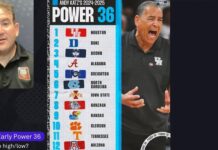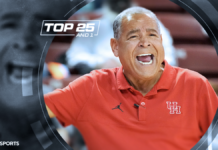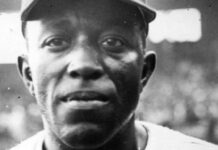It’s starting to play out a little bit clearer now. For months, Jacksonville has been locked in during the draft. It’s appeared as if the New York Jets have been as well. Then, San Francisco traded all the way up to No. 3 and you don’t do that unless there’s a player you know you badly want.
All of which sets up very interestingly for the Atlanta Falcons. Not necessarily good. Definitely not bad. Just…interesting, because it leaves new general manager Terry Fontenot and new head coach Arthur Smith with options in their first Falcons draft.
Working on the premise San Francisco or the Jets don’t pull a stunner, the top three picks should go quarterback-quarterback-quarterback, with Trevor Lawrence and Zach Wilson expected to be two of those players.
The intrigue begins at No. 4. There are a few different ways for the Falcons to go.
Draft a quarterback
As a general manager and coach, you don’t want to be perennially picking in the Top 5. If you are, you likely aren’t going to have your job for very long. So while Atlanta is here, investing in a quarterback would be one very obvious way to go.
How Atlanta handles this could depend on what its board looks like. If a quarterback the team views in the Top 5 is available — and at least of Trey Lance, Justin Fields and Mac Jones should be available — then it makes sense to pick the signal-caller.
There are wrinkles here, though. Barring an injury to Matt Ryan, a quarterback would not play in 2021. It would be highly unlikely the quarterback would play in 2022, either, although according to Roster Management System, Atlanta would save $23.75 million in cap space if he were to be a designated post-June 1 cut (while still carrying $24,921,500 in dead money).
• Can Bears ever break vicious QB cycle?
• Falcons have options in draft at No. 4
• Browns sign leader in LB Walker
• Jets’ Darnold would ’embrace’ rookie competition
• Patriots pause at QB with Cam, Stidham
So if Atlanta views the soon-to-be-36-year-old Ryan as a player to build around for the next three years, then a quarterback wouldn’t make sense because almost half of the player’s rookie contract will be sitting behind Ryan.
There are two reasons to take a quarterback here: Your plan is to move on from Ryan somewhere in the near future after 2021 or you believe the player is so transformative he’s your quarterback for the next decade-plus post-Ryan. If neither one of those things are true, better to get an elite talent at another position and draft a quarterback later on you can potentially develop.
Atlanta currently has one quarterback on the roster — Ryan — so the Falcons need someone there. Who it is could determine so much about the short- and long-term future of the franchise. It’s the first truly big decision for Fontenot and Smith and one that could define their early tenures.
Take Oregon offensive lineman Penei Sewell
The question here might be how the Falcons view Sewell. He’s 6-foot-6, 325 pounds and has his experience at tackle, so that would be the more sensible spot. While it would be a surprise to see him at guard — the Falcons have Jake Matthews and Kaleb McGary at tackle already, so guard could be the short-term play. To take a player you view as a long-term guard at No. 4 would be a stretch — the last guard to go in the Top 10 was Quenton Nelson to Indianapolis in 2018 — but if the long-term play would be for Sewell to be a tackle, he would be worth the investment.
McGary is under contract through 2022 and Matthews through 2023 so Sewell could be inside for a year before moving outside since neither player has guaranteed money left on their deals should Atlanta go this route. And taking a tackle in the Top 5 is not unheard of — the Giants did so last year at No. 4 with Andrew Thomas.
But Sewell will upgrade the offensive line if Atlanta picks him and could offer a blindside protector for the next decade for whoever is playing quarterback for the Falcons. It won’t be an exciting pick, but it might be a safe one with a high floor and high ceiling. Sewell is an elite prospect.
Draft Florida TE Kyle Pitts
It might seem high to take a tight end at No. 4 — it hasn’t been done in the Super Bowl era. Just twice has a tight end gone in the Top 5: Hall of Famer Mike Ditka in 1961 and four-time Pro Bowler Riley Odoms in 1972. Both went fifth.
That said, Pitts is a different type of player and the NFL has evolved offensively to where tight ends are becoming more valuable by the year in offenses. The 6-foot-6, 245-pound Pitts ran an unofficial 4.44-second 40-yard dash time, jumped 33½ inches in the vertical and had 22 bench press repetitions at Florida’s pro day. He’s not what a tight end used to be. He is what a tight end could end up being in the future.
“He’s a different bird than what a traditional tight end has been,” said Detroit Lions head coach Dan Campbell, a former NFL tight end. “Or certainly has been when I played.”
He’s young, too, which theoretically means more room for growth in the future. He won’t turn 21 until October and increased his production every year at Florida (although he had fewer receptions in a COVID-altered 2020 season). In less than three full seasons, he became Florida’s all-time leader for receiving yards by a tight end (1,492) and second in receptions (100).
Tight end is a difficult position to transition to from college to the NFL, even for first round, Top 10, picks. But Atlanta’s roster construction can help here, too. Hayden Hurst is in the last year of his contract (although Atlanta could pick up his fifth-year option) and Lee Smith is on a one-year deal. At receiver, Calvin Ridley is in a contract year (although, like Hurst, Atlanta has a fifth-year option) and Julio Jones is under contract until 2023.
But putting Pitts in a pass-catching corps with Jones, Ridley and Hurst could be a nightmare for opposing defenses for the next two seasons, at least.
Trade down
This goes back to the quarterback. If there are teams — Carolina, Denver, New England and Washington are candidates — who desperately want one of the remaining quarterbacks, Fontenot could move off of the pick and trade down to pick up more future draft capital. You need a willing trade partner in order to pull this off, but Atlanta might actually have some options.
Considering the state of the roster, this would not be the worst move if he were able to pull it off. Trading back also opens up a more realistic option of taking a defensive player — linebacker Micah Parsons could be available at Nos. 8 or 9, for example, and defensive lineman Kwity Paye and linebacker Jeremiah Owusu-Koramoah could be available later than that. Corners Caleb Farley and Patrick Surtain II could end up in that mix, too, depending where Atlanta moved down to. And other players could be involved here, too, as the middle of Round 1 is where the top defenders might start coming off the board.
Atlanta has 20 players under contract for 2022, although that number could go up if Hurst and Ridley receive their fifth-year options, and the defense will need new, young talent. While defensive players aren’t the elite of the elite in this year’s draft, there are talented playmakers available and if Fontenot can use No. 4 as a way to get more picks to bolster the long-term building of the roster, it might be the best play for Atlanta to make if it isn’t in love with a quarterback.










































